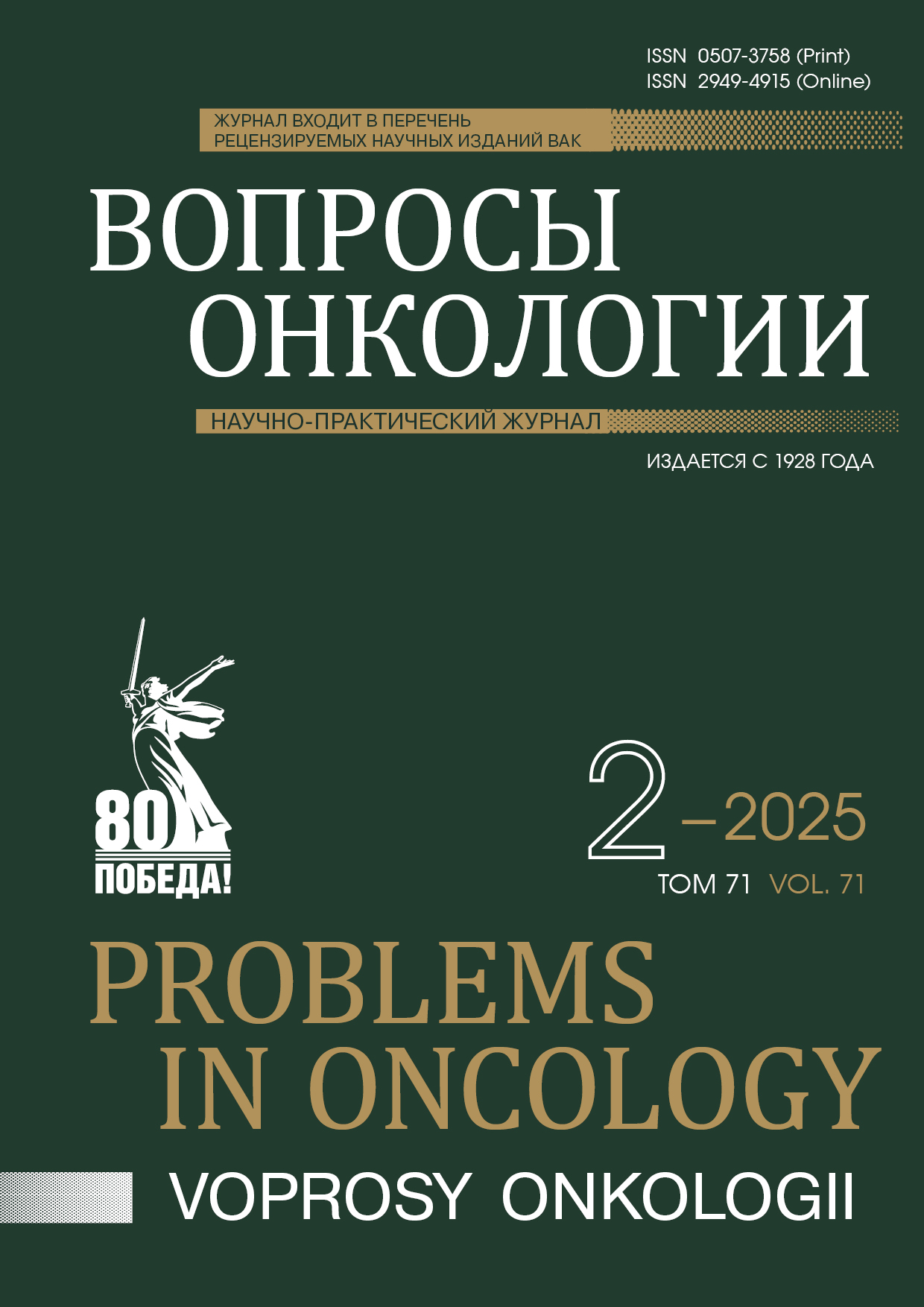Abstract
Introduction. Against the background of the increasing volume of specific drug therapy used, recommendations and instructions on the use of antitumor drugs are being created throughout the country, as well as offices and departments of centralized breeding are being introduced, but the results of such work are reflected in isolated publications in a short period of time.
Aim. To analyze the expediency of creating and the effectiveness of the centralized breeding department in an urban oncological medical institution using the example of the St. Petersburg Clinical Scientific and Practical Center for Specialized Types of Medical Care (Oncological) named after N.P. Napalkov.
Materials and Methods. The analysis was carried out using the available electronic and paper media (journals) of the department, applications for dilution and pharmacy data on the purchase of medicines for the period 2014-2024.
Results . The establishment of the department made it possible to increase the safety of staff and patients during chemotherapy, reduce the number of errors in prescribing therapy, increase control over the prescription of medicines and their write-off, reduce the workload on nurses in clinical departments and improve the quality of prepared solutions. The work of the department allows to save 10 % of the purchase of medicines, relative to decentralized breeding. There remains a need for a regulatory framework, recommendations on the work of offices / departments of centralized breeding, as well as quality control of prepared solutions.
Conclusion. The work of the department of centralized dilution of medicines in the St. Petersburg KNPCSVMP(o) named after N.P. Napalkov is an example of the effective use of medicines, especially in conditions of increasing cost of patient treatment and a shortage of the healthcare budget. The practice of the N.P. Napalkov Cancer Center can be used in other medical organizations for more rational use of chemotherapeutic drugs.
References
Chen Y., Jia Y., Song W. et. al. Therapeutic potential of nitrogen mustard-based hybrid molecules. Front Pharmacol. 2018; 17(9): 1453.-DOI: https://doi.org/10.3389/fphar.2018.01453.
Needham D., Cohen J., Barrett A. The mechanism of damage to the bone marrow in systemic poisoning with mustard gas. Biochem. J. 1947; 41(4): 631-639.-DOI: https://doi.org/10.1042/bj0410631.
Ghanei M. Delayed haematological complications of mustard gas. J. Appl. Toxicol. 2004; 24(6): 493-495.-DOI: https://doi.org/10.1002/jat.1006
Cairns J. The treatment of diseases and the war against cancer. Sci Am. 1985; 253(5): 51-59.-DOI: https://doi.org/10.1038/scientificamerican1185-51.
Duffy M. The war on cancer: are we winning? Tumour Biol. 2013; 34(3): 1275-1284.-DOI: https://doi.org/10.1007/s13277-013-0759-2.
Christakis P. The birth of chemotherapy at Yale. Bicentennial lecture series: surgery Grand Round. Yale J. Biol. Med. 2011; 84 (2): 169-172.
Vincent T., Jr., Chu E. A history of cancer chemotherapy. Cancer Res. 2008; 68(21): 8643-8653.-DOI: https://doi.org/10.1158/0008-5472
American Cancer Society. Chemotherapy Safety. 2024.-URL: https://www.cancer.org/cancer/managing-cancer/treatment-types/chemotherapy/chemotherapy-safety.html.
Hemminki К., Kyyrönen P., Lindbohm M. Spontaneous abortions and malformations in the offspring of nurses exposed to anaesthetic gases, cytostatic drugs, and other potential hazards in hospitals, based on registered information of outcome. J. Epidemiol. Community Health. 1985; 39(2): 141-7.-DOI: https://doi.org/10.1136/jech.39.2.141.
Krstev S., Perunicić B., Vidaković A. Work practice and some adverse health effects in nurses handling antineoplastic drugs. Med. Lav. 2003; 94(5): 432-9.
Gabriele P., Airoldi M., Succo G., et al. Undifferentiated nasopharyngeal-type carcinoma in a nurse handling cytostatic agent. Eur. J. Cancer В Oral Oncol. 1993: 153-15.-DOI: https://doi.org/10.1016/0964-1955(93)90040-l.
Levin L., Holly E., Seward J. Bladder cancer in a 39-year-old femal pharmacist. J. Natl. Cancer Inst. 1993; 85(13): 1089-1091.-DOI: https://doi.org/10.1093/jnci/85.13.1089.
Тюляндин С.А., Самойленко И.В., Измерова Н.И., et al. Руководство для медицинского персонала по безопасному обращению с противоопухолевыми препаратами 2012. 2024.-URL: https://rosoncoweb.ru/standarts/medical_staff/001.pdf. [Tyulyandin S., Samoylenko I., Izmerova N., et. al. Guidelines for medical personnel on the safe handling of antitumor drugs 2012. 2024.-URL: https://rosoncoweb.ru/standarts/medical_staff/001.pdf. (In Rus)].
Burgaz S. Karahalil B., Canhi Z., et al. Assessment of genotoxic damage in nurses occupational exposed to antineoplastics by the analysis of chromosomal aberrations. Hum. Exp. Toxicol. 2002; 21(3): 129-135.-DOI: https://doi.org/10.1191/0960327102ht230oa.
Raveena R., Tejinder B., Genevieve G. et. al. Occupational exposure to chemotherapy of pharmacy personnel at a single centre. Can J Hosp Pharm. 2015; 68(2): 104-12.-DOI: https://doi.org/10.4212/cjhp.v68i2.1435.
Fuchs J., Hengstler J., Jung D. et al. DNA damage in nurses handling antineoplastic agents. Mutat. Res. 1995; 342(1-2): 17-23.-DOI: https://doi.org/10.1016/0165-1218(95)90086-1.
Nygren O., Lundgren C. Determination of platinum in workroom air and in blood and urine from nursing staff attending patients receiving cisplatin chemotherapy. Int. Arch. Occup. Environ. Health. 1997; 70(3): 209-214.-DOI: https://doi.org/10.1007/s004200050209.
Bach P., Conti R., Muller R. et.al. Overspending driven by oversized single dose vials of cancer drugs. B.M.J. 2016; 352(i788).-DOI: https://doi.org/10.1136/bmj.i788.
Paul J. Sessink G., Graham S., et. al. Preventing occupational exposure to cytotoxic and other hazardous drugs European Policy Recommendations. Exposure to cytotoxic drugs recommendations. 2024.-URL: https://www.europeanbiosafetynetwork.eu/wp-content/uploads/2016/05/Exposure-to-Cytotoxic-Drugs_Recommendation_DINA4_10-03-16.pdf.
Geersing T., Klous M., Franssen E., et al. Robotic compounding versus manual compounding of chemotherapy: Comparing dosing accuracy and precision. Eur J. Pharm Sci. 2020; 155: 105536.-DOI: https://doi.org/10.1016/j.ejps.2020.105536.

This work is licensed under a Creative Commons Attribution-NonCommercial-NoDerivatives 4.0 International License.
© АННМО «Вопросы онкологии», Copyright (c) 2025

